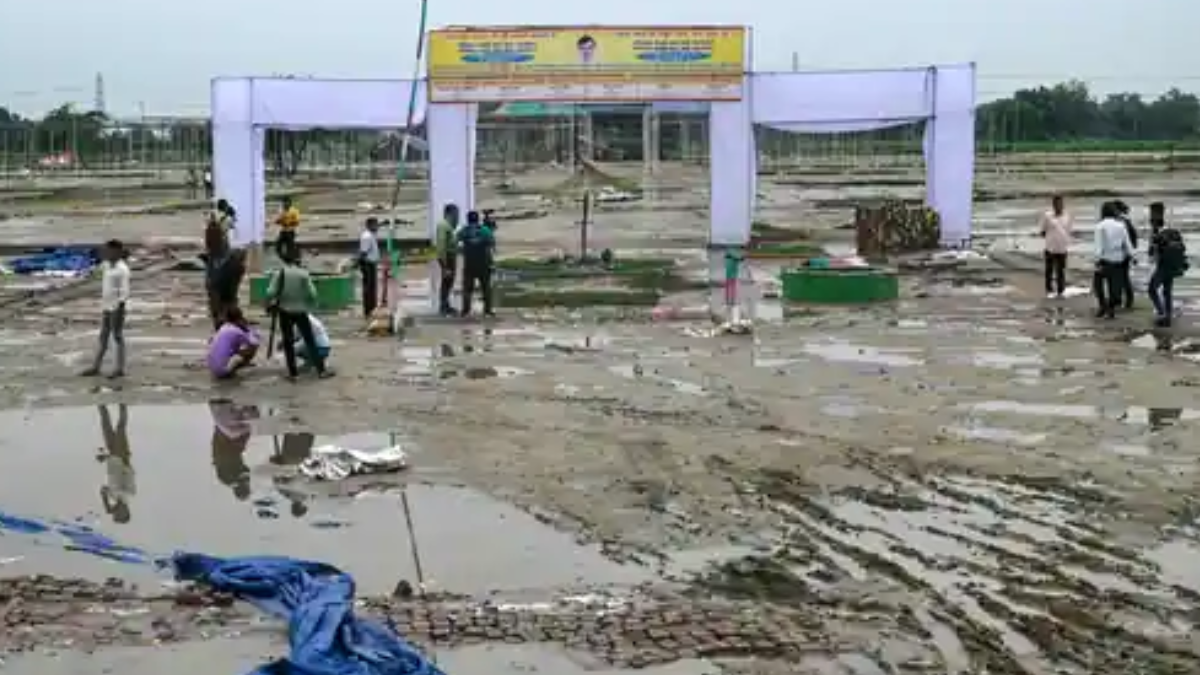Tragic Incident in Hathras, Uttar Pradesh: 121 Dead in Stampede During Religious Event
The tragic stampede in Hathras, Uttar Pradesh, resulting in 121 deaths during a religious event, has not only shocked the nation but also raised serious questions about safety protocols and crowd management in such gatherings.

Image Source: Aaj Tak
The incident occurred in a vast, muddy field, exacerbated by recent heavy rains that left the ground slippery and difficult to navigate. This environmental factor played a critical role in the unfolding tragedy, as thousands of attendees, including women and children, struggled to move safely after the religious discourse ended. The sudden rush to see the spiritual leader led to chaos, with people jostling in the muddy terrain, ultimately resulting in a stampede.
Eyewitness accounts vividly describe the panic and desperation as individuals tried to escape the stampede, cries for help echoing amidst the confusion. The response from local authorities and rescue teams was swift, yet the sheer scale of the disaster meant that casualties continued to rise even as efforts were made to rescue and treat the injured.
Political leaders, including Prime Minister Narendra Modi and Chief Minister Yogi Adityanath, promptly offered condolences to the bereaved families and ordered a judicial inquiry to ascertain responsibility. Chief Minister Adityanath’s visit to the injured underscored the government’s commitment to providing assistance and support to those affected.
In the wake of this tragedy, questions have emerged about the adequacy of safety measures and crowd control at large-scale events, particularly in rural areas where infrastructure and preparedness might be lacking. The need for stringent protocols to prevent such incidents in the future is evident, including better planning of event logistics, improved emergency response preparedness, and enhanced public safety awareness.
The Hathras stampede has not only left a profound impact on the local community but has also sparked nationwide discussions on safety standards during public gatherings. It serves as a stark reminder of the importance of proactive measures to safeguard lives, ensuring that tragedies like this are prevented through careful planning and robust implementation of safety guidelines.
As the region mourns the loss of so many lives, efforts are underway to provide support to the affected families and to learn from this devastating event to prevent similar occurrences in the future. The judicial inquiry will be crucial in identifying lapses and holding accountable those responsible for the lapses that led to this unfortunate incident.
Postmortem Report
The postmortem reports revealed grim details of the injuries suffered by the victims, ranging from fractures to severe head injuries and internal trauma. The injured were rushed to nearby hospitals, where medical teams worked tirelessly to stabilize them. The aftermath of such incidents not only involves medical and humanitarian responses but also demands a thorough investigation into the circumstances that led to such a catastrophic loss of life.
From early morning until late at night, the post-mortem house echoed with unceasing cries of mourning. The faces of the people gathered there bore expressions of grief and sorrow, reflecting the profound loss felt by the community. Despite the somber atmosphere, there was a palpable sense of acceptance and reverence, especially concerning Bhole Baba. No dissenting voices were heard, and no criticisms were voiced regarding Bhole Baba.
The Hathras stampede serves as a stark and tragic reminder of the vulnerabilities inherent in large gatherings. It underscores the urgent necessity for robust safety protocols and meticulous planning to safeguard public welfare during such events. The incident, which unfolded amidst a festive atmosphere, turned into a scene of chaos and devastation, leaving families shattered and communities reeling from the sudden loss of loved ones.
In the aftermath of the stampede, authorities have been called upon to investigate the causes and factors that led to the tragic event. Questions have been raised about crowd control measures, emergency response protocols, and the adequacy of security arrangements. These concerns have sparked a broader conversation about the responsibilities of event organizers, local authorities, and law enforcement agencies in ensuring the safety and security of attendees.
The tragedy has prompted calls for accountability and justice from affected families and concerned citizens alike. There is a collective demand for a thorough inquiry and stringent measures to prevent such incidents from recurring in the future. As the nation mourns the lives lost in Hathras, there is also a renewed determination to learn from this heartbreaking episode and implement concrete measures to enhance safety standards across all public gatherings.
Moving forward, the focus remains on healing and supporting the affected families, while also addressing systemic issues related to crowd management and event safety. It is a time for reflection, compassion, and concerted action to honor the memories of those who perished tragically in Hathras and to prevent similar tragedies from unfolding elsewhere in the country. The resolve to prioritize public safety and welfare stands as a testament to our collective commitment to safeguarding lives and ensuring that such heartbreaking incidents never happen again.



